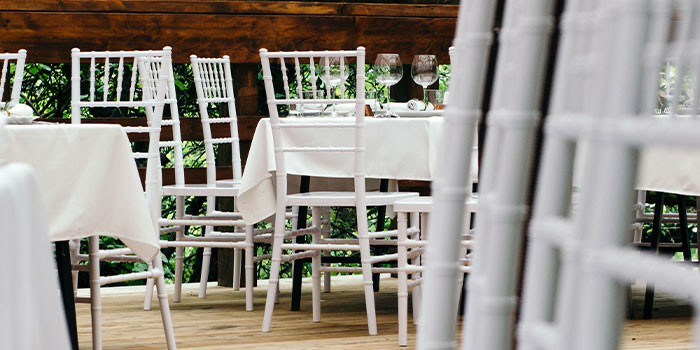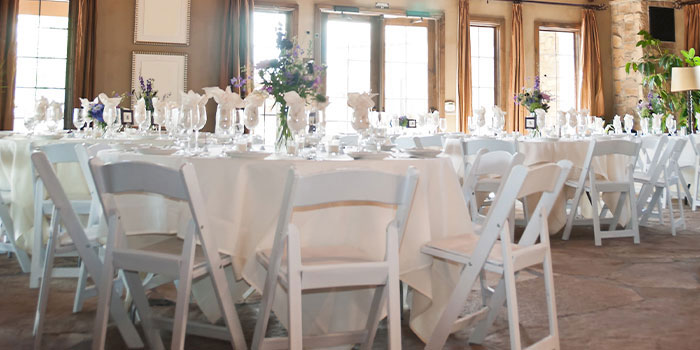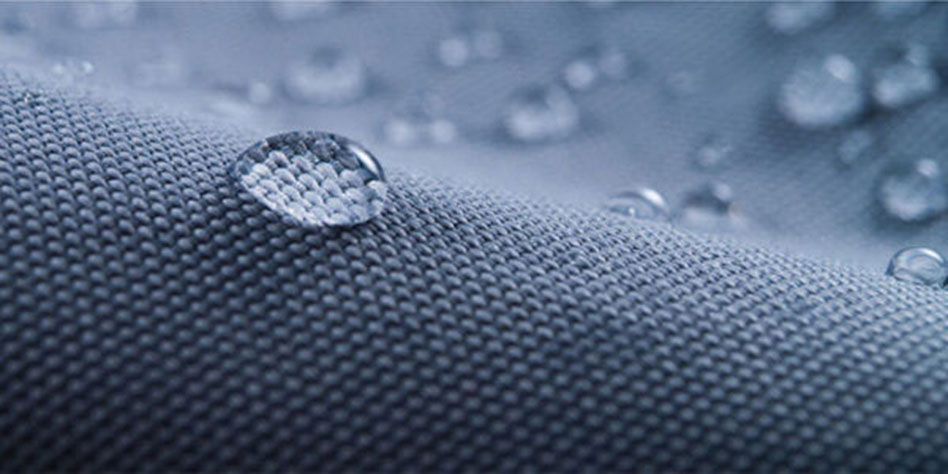
Stuhlpolster müssen wie Ihre Kleidung gewaschen werden. Eine regelmäßige, leichte Reinigung ist die beste Methode, um das schöne Aussehen Ihrer Stühle zu bewahren.
Hier finden Sie detaillierte Anweisungen zur Reinigung der Polsterstoffe, die bei MityLite-Stühlen verwendet werden.
Desinfizieren Sie Stuhlpolster, um die Verbreitung von Keimen zu verhindern
Sind Sie besorgt, die Verbreitung von Bakterien und Viren bei Ihren Veranstaltungen zu minimieren? EPA-registriert Desinfektionsmittel die die Kriterien für den Einsatz gegen SARS erfüllen, können auch zur Desinfektion von Textilien verwendet werden und so die Ausbreitung des Coronavirus und anderer ansteckender Krankheiten verhindern.
Die Centers for Disease Control empfehlen die Verwendung der folgenden Produkte zur Desinfektion von Stühlen und Tischen in öffentlichen Bereichen.
- Asepticare™
- Bleichmittel 1:10 (10% Bleichmittel)
- Bleach-Rite® Desinfektionsspray
- CaviCide™
- CaviCide1™
- Clorox® Healthcare Bleach keimtötender Reiniger
- Clorox® Wasserstoffperoxid-Reiniger-Desinfektionsspray
- Diversey™ Avert® Sporizider Desinfektionsreiniger
- Lysols Clean & Fresh Multi-Surface-Reiniger
- Oxivir® 1 RTU
- Oxivir® TB
- OxyCide™ Täglicher Desinfektionsreiniger
- Virex II 256
So reinigen Sie Olefingewebe (einschließlich Sherpa- und Shire-Stoffe)
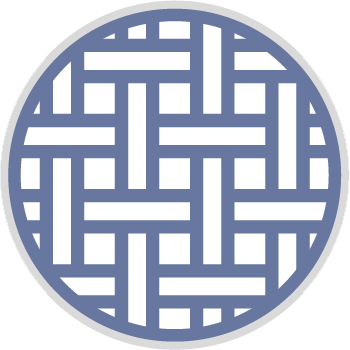
Für Sherpa- und Shire-Polsterstoffe (und andere 100%-Olefinstoffe) wird die folgende Desinfektionsbehandlung zur Desinfektion gegen Keime und Viren, sogar gegen das Coronavirus (COVID-19), empfohlen.
Verwenden Sie ein Haushaltsbleichmittel (einschließlich). 5.25% oder 6.00%–6.15% Natriumhypochlorit je nach Herstelleretikett) verdünnt in Wasser bei einer Verdünnungsverhältnis 1:10, das ist 1,5 Tassen Bleichmittel in 1 Gallone Wasser. Die Verwendung von Bleichmittel auf Sherpa- und Shire-Olefingewebe hat keine schädlichen Auswirkungen und die empfohlenen Behandlungen führen nicht zum Erlöschen der Garantie. Es wird jedoch trotzdem empfohlen, die Reinigungslösung zunächst an einer unauffälligen Stelle zu testen, bevor Sie sie im gesamten Gewebe verwenden.
Bereiten Sie die Lösung vor jedem Gebrauch frisch zu, da Bleichmittel lichtempfindlich ist. Beachten Sie auch, dass Bleichmittel ein Jahr nach der Herstellung abläuft und seine Wirksamkeit verlieren kann, wenn es nicht richtig gelagert wird.
Entfernen Sie vor der Desinfektion organischen Schmutz und große Mengen verschütteter Stoffe. Die Desinfektion erfordert eine empfohlene Nasskontaktzeit von 10 Minuten effektiv sein. Denken Sie daran, dass Chlorlösungen ätzend sind und Metall angreifen und die Haut schädigen können.
Mischen Sie Bleichmittel niemals mit Produkten, die Ammoniak oder Säuren enthalten.
So reinigen Sie 100%-Polyesterpolster und Polyestermischungen
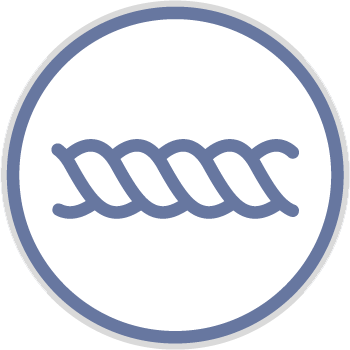
Zum Reinigen von Polstern, die aus 100%-Polyester oder Polyestermischungen hergestellt sind, verwenden Sie am besten Produkte mit Wasserstoffperoxid.
Wir empfehlen die Verwendung von etwas wie Clorox® Wasserstoffperoxid-Reiniger und Desinfektionsmittel. Dieses Produkt, das sowohl als Spray (für Textilien) als auch als Tuch (für harte Oberflächen) erhältlich ist, tötet Krankheitserreger auf harten und weichen Oberflächen ab und kann Bakterien und Viren in 30 Sekunden beseitigen. Dieser Industriereiniger kann auf eine Vielzahl von Stoffen aufgetragen werden, einschließlich solcher aus 100%-Polyester. Dieser Reiniger enthält keine flüchtigen organischen Verbindungen (VOCs), keine scharfen Dämpfe, kein Bleichmittel und keinen zusätzlichen Duftstoff, und der Wirkstoff Wasserstoffperoxid zerfällt bei Gebrauch in Wasser und Sauerstoff. Dennoch empfiehlt es sich, die Reinigungslösung zunächst an einer kleinen, unauffälligen Stelle zu testen.
Beachten Sie, dass Polyester und Polyestermischgewebe empfindlich auf die Wirkung von Bleichmitteln reagieren. A 3% Bleichlösung (1/3 Tasse Bleichmittel auf 1 Gallone Wasser) ist die höchste Konzentration, die verwendet werden kann, es kann jedoch nicht garantiert werden, dass die langfristige Verwendung einer Bleichlösung kein Problem darstellt.
Ein weiteres empfohlenes Produkt zur Reinigung von Polstern ist Lysol® Clean & Fresh Multi-Surface Cleaner, der auch von der EPA für seine virenbekämpfenden Eigenschaften registriert ist und 99,9% Viren und Bakterien abtötet. Der Wirkstoff, Alkyl-Dimethyl-Benzyl-Ammoniumchlorid, wurde mit verschiedenen gesundheitsschädlichen Auswirkungen in Verbindung gebracht, daher sollten Sie Hautkontakt, Einatmen oder versehentliches Verschlucken vermeiden.
Halten Sie das Produkt wie alle wirksamen Reinigungsmittel von Kindern fern, tragen Sie es nur in gut belüfteten Bereichen auf und waschen Sie die Oberflächen nach Gebrauch mit klarem Wasser ab.
So reinigen Sie Crypton- und Nanotex-Gewebe
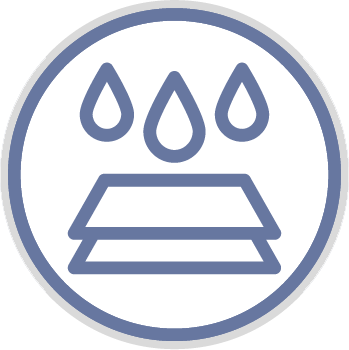
Nanotex- und Crypton-Stoffe sind mehrschichtige Materialien mit antimikrobieller und schmutzabweisender Technologie und einer integrierten, dauerhaften Flüssigkeitsbarriere. Cryptons patentierte Feuchtigkeitsbarriere verhindert nachweislich, dass Feststoffe und Flüssigkeiten in das darunterliegende Kissen eindringen. Dies macht Crypton-Stoffe zu einem der am einfachsten zu reinigenden Polsterstoffe.
Es kann jedoch vorkommen, dass eine Oberfläche sauber erscheint, aber nicht desinfiziert ist. Crypton empfiehlt die Verwendung ihres von der EPA zugelassenen Desinfektions- und Geruchsneutralisierers auf Crypton Barrieregeweben. Diese Formel wurde für stark beanspruchte Umgebungen entwickelt. Dies ist ein einstufiger Desinfektionsreiniger, der gegen ein breites Spektrum an Bakterien, Viren, Schimmel, Mehltau und Pilzen wirksam ist.
Und das Beste: Dieses Desinfektionsmittel verhindert wirksam die Ausbreitung von Bakterien und Viren.
Um den Stoff gründlich zu desinfizieren und zu reinigen, gehen Sie wie folgt vor:
- Verschüttetes mit saugfähigem Tuch oder Papiertuch entfernen. Stark verschmutzte Stellen ggf. mit Wasser und Seife reinigen.
- Entfernen Sie überschüssige Feuchtigkeit und Seife mit einem Staubsauger oder durch Abwischen mit einem sauberen, trockenen Tuch. Entfernen Sie die gesamte Seife, damit sie keinen Schmutz anzieht.
- Testen Sie das Desinfektionsmittel und Desodorierungsmittel von Crypton an einer kleinen, unauffälligen Stelle.
- Anwenden Desinfektionsmittel und Desodorierungsmittel von Crypton indem Sie es 15-20 cm von der Oberfläche entfernt halten. Dämpfe aus dem Spray nicht einatmen.
- Spülen Sie den Stoff nach der Anwendung mit Wasser ab.
- Lassen Sie die Oberfläche 10 Minuten lang feucht.
- Nach 10 Minuten trockenwischen oder an der Luft trocknen lassen.
So reinigen Sie gewebte und beschichtete Polyesterstoffe
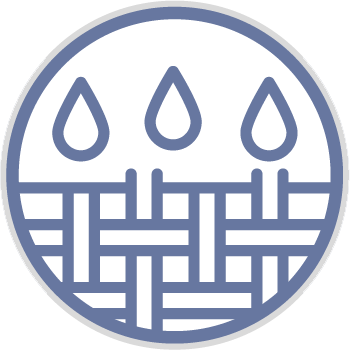
Zur allgemeinen Pflege von gewebten und beschichteten Polyesterstoffen saugen Sie die Oberflächen regelmäßig ab, um Staub und lose Partikel zu entfernen, reinigen Sie alle Schmutz- und Fleckenbereiche und desinfizieren Sie sie regelmäßig.
Vergewissern Sie sich zur Desinfektion zunächst, dass die Verwendung von Bleichmitteln für Ihr Produkt sicher ist, indem Sie einen kleinen Bereich an einer unauffälligen Stelle testen. Mischen Sie eine Lösung aus Bleichmittel und sauberem Wasser mit einem Verhältnis 1:10. Schützen und decken Sie den Möbelrahmen und die umliegenden Bereiche ab und arbeiten Sie in einem gut belüfteten Bereich mit Handschuhen und Augenschutz.
Spülen Sie die Polsterung nach der Desinfektion mehrmals mit klarem Wasser ab. Bleichmittelreste im Stoff können den Stoff beschädigen oder seine Lebensdauer verkürzen.
So reinigen Sie gewebte und gestrickte Stoffe

Die folgende Liste empfohlener Reinigungsmittel kann zum Desinfizieren von gewebten und gestrickten Stoffen und zur Verhinderung der Verbreitung von Viren, Bakterien und anderen ansteckenden Krankheiten verwendet werden. Beachten Sie, dass diese Reinigungsprodukte nicht gründlich an allen Stoffarten und -stilen getestet wurden. Die folgenden Informationen sind daher eher als allgemeine Vorschläge denn als Empfehlungen zu betrachten. Testen Sie die Reinigungslösung immer zuerst an einer kleinen, unauffälligen Stelle.
- Lysol-Desinfektionsspray
- Tücher auf Peroxidbasis (verschiedene Marken)
- Alkoholtupfer mit oder ohne quartärem Desinfektionsmittel (verschiedene Marken)
Desinfektionshinweise:
Befeuchten Sie den Stoff leicht und lassen Sie ihn an der Luft trocknen. Beachten Sie, dass bei der Verwendung von Tüchern, wenn Farbe auf das Tuch übertragen wird, der Stoff gegenüber diesem Produkt nicht farbecht ist und diese Tücher nicht verwendet werden sollten. Vermeiden Sie die Verwendung von Tüchern auf Bleichmittelbasis, es sei denn, der Stoff ist bekanntermaßen farbecht gegenüber Bleichmitteln. Wenn nicht bekannt, gehen Sie davon aus, dass der Stoff nicht bleichmittelsicher ist.
Desinfektion im Gesundheitswesen:
Die meisten Krankenhausdesinfektionsmittel sind für die Verwendung auf harten Oberflächen vorgesehen und eignen sich im Allgemeinen nicht für gewebte oder gestrickte Stoffe. Mit den folgenden Reinigungsprodukten wurden jedoch nur begrenzte Tests durchgeführt, und sie scheinen weder die Farbe noch die Integrität des Stoffes zu beeinträchtigen. Befolgen Sie sorgfältig die Anweisungen auf dem Etikett, insbesondere hinsichtlich der Verdünnung des Desinfektionsmittels.
- Virex II 256
- Oxivir TB
- Super Sani Cloth keimtötende Tücher
- Cavicide und Cavicide Wipes
Hinweise zur Desinfektion im Gesundheitswesen:
Befeuchten Sie die Stoffoberfläche leicht und lassen Sie sie trocknen – durchtränken Sie den Stoff nicht. Wenn Sie das Produkt mehrmals verwenden möchten, spülen Sie es mit klarem Wasser ab, um die Bildung chemischer Rückstände auf dem Stoff zu verhindern.
So reinigen Sie Polyurethanpolster
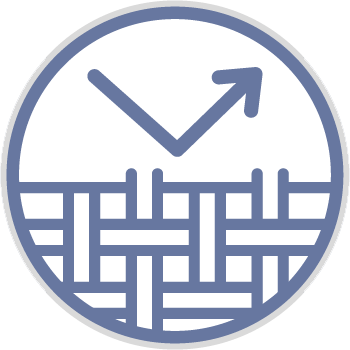
Zur allgemeinen Pflege von Polyurethan-Stoffen saugen Sie Oberflächen regelmäßig ab, um Staub und lose Partikel zu entfernen, reinigen Sie alle Schmutz- und Fleckenbereiche und desinfizieren Sie sie.
Behandeln Sie Flecken so schnell wie möglich. Es wird immer schwieriger, einen Fleck zu entfernen, je länger er aushärten kann. Entfernen Sie feste oder halbfeste Substanzen mit einem flachen Gegenstand. Entfernen Sie so viel Fleck wie möglich und saugen Sie ihn anschließend gründlich mit den richtigen Aufsätzen ab, bevor Sie ihn mit einem Reinigungsmittel reinigen.
Testen Sie jede Reinigungsmethode oder jedes Desinfektionsmittel vorab an einer kleinen, versteckten und unauffälligen Stelle, um sicherzustellen, dass der Stoff nicht beschädigt wird. Wir empfehlen, mehrere weniger konzentrierte Reinigungslösungen anstelle einer konzentrierten Anwendung zu verwenden, da dadurch der Stoff weniger beschädigt wird. Sie sollten außerdem das Möbelgestell und die umliegenden Bereiche schützen und abdecken und in einem gut belüfteten Bereich mit Handschuhen und Augenschutz arbeiten.
Vermeiden Sie, dass Reinigungsflüssigkeiten in die Stoffoberfläche eindringen. Entfernen Sie Flüssigkeiten sofort durch Abtupfen mit einem sauberen, farbechten und saugfähigen Tuch.
Entfernen Sie Flecken mit einer weichen Bürste oder einem Schwamm und tragen Sie anschließend warmes Seifenwasser auf den Fleck auf. Machen Sie es nicht zu nass, da sonst ein Ring entstehen und die restliche Reinigungslösung aufgesaugt werden könnte. Führen Sie leichte, schnelle Striche aus, beginnen Sie an der Außenseite des Flecks und arbeiten Sie sich zur Mitte hin vor. Vermeiden Sie es, den Bereich zu reiben oder zu schrubben, da dies den Stoff beschädigen kann. Entfernen Sie eventuelle Rückstände mit einem sauberen Tuch und kaltem Wasser.
Lassen Sie den Stoff gründlich trocknen und verwenden Sie keine Hitze, da sich der Fleck dadurch im Stoff festsetzt. Wie bei gewebten und gestrickten Stoffen sollten Sie den Stoff nach dem Auftragen des Bleichmittels gut ausspülen, um eine Beschädigung des Stoffes zu vermeiden.
So reinigen Sie Vinylpolster (PVC)

Zur Desinfektion von Vinylpolstern aus PVC (Polyvinylchlorid) empfehlen wir die Verwendung dieser von der EPA zugelassenen Lösungen, die nachweislich eine desinfizierende Wirkung gegen COVID-19 und andere Stämme des Coronavirus haben.
- Eine Lösung von 10% Bleichmittel gemischt mit 90% sauberes Wasser
- Super Sani-Tücher
- Virex™ II, 256
Testen Sie jede Reinigungsmethode oder jedes Reinigungsmittel immer vorab an einer kleinen, versteckten und unauffälligen Stelle, um sicherzustellen, dass der Stoff nicht beschädigt wird.
Beachten Sie, dass Reinigungs- und Desinfektionsmittel in der empfohlenen Verdünnung und niemals in konzentrierter Form verwendet werden sollten. Wischen Sie Desinfektionsmittel unbedingt mit klarem Wasser ab und trocknen Sie das Vinyl anschließend mit einem sauberen Tuch ab, um alle chemischen Rückstände zu entfernen, die die Oberfläche des Materials verfärben oder beschädigen könnten.
Wenn eine Polsterreinigung nicht ausreicht
Wenn Ihre Veranstaltungsstühle in die Jahre gekommen sind und Reinigung und Desinfektion nicht mehr ausreichen, ist es vielleicht an der Zeit, sie zu erneuern oder auszutauschen. Stöbern Sie im Katalog von MityLite mit langlebigen gepolsterte Bankettstühle.

Werten Sie Ihren Raum mit neuen Möbeln auf. Kontakt einen Vertriebsmitarbeiter!
